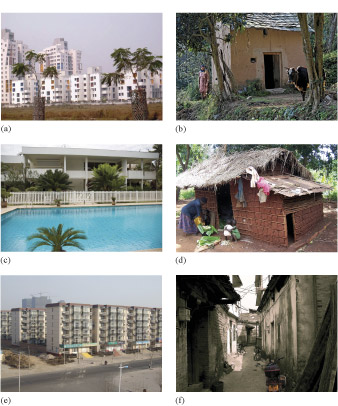2.3.3 Differences between people and places
Mean individual and household carbon footprints for a country conceal the differences within that country. As you saw for the UK, these differences in carbon footprints are strongly related to income and can be very great.
For example:
- in India the 2015 mean carbon footprint of 1.7 tonnes CO2 per person per year hides the differences between middle-class Indian households living in air-conditioned apartments and owning a television, refrigerator and motor scooter, or perhaps a car (Figure 11(a)), and the household of a subsistence farmer, whose only fuel is dried cow dung for cooking, and perhaps kerosene for a lamp (Figure 11(b))
- in Africa, the contrast between the elite, who may have a private swimming pool, and villagers who have to collect water for cooking and washing (Figures 11(c) and (d)) is not shown
- in China, where the lifestyles of the wealthier members of the very rapidly growing urban population still contrast with those of people living in China’s villages and rural areas (Figures 11(e) and (f)).

Figure 11 (a) Apartments, New Town, Kolkata, India, built for India’s fast-growing middle class; (b) Indian cattle farmer living on less than £1 per day; (c) government official’s house, Libreville, Gabon; (d) villager’s house, Jinja, Uganda; (e) typical apartment block, China; (f) village alley, near Yangshuo, China
